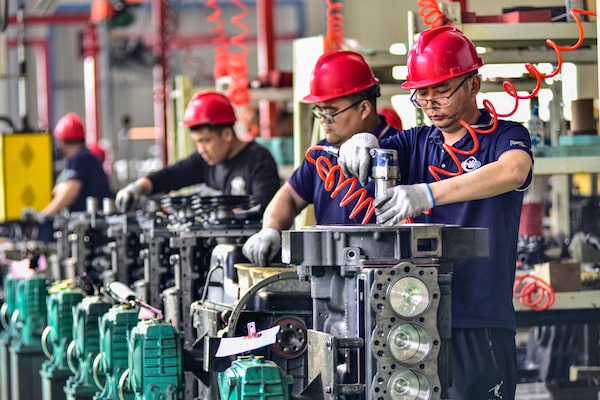
Employees work on an engine assembly line at a factory in Qingzhou, in China's eastern Shandong province, on April 16.STR/Getty Images
China’s economy grew faster than expected in the first quarter, data showed on Tuesday, offering some relief to officials as they try to shore up growth in the face of protracted weakness in the property sector and mounting local government debt.
However, several March indicators released alongside the gross domestic product data – including property investment, retail sales and industrial output – showed that demand at home remains frail, weighing on overall momentum.
The world’s second-largest economy grew 5.3 per cent in January-March from the year earlier, official data showed, comfortably above a 4.6 per cent analysts’ forecast in a Reuters poll and up from the 5.2 per cent expansion in the previous quarter. On a quarterly basis growth picked up to 1.6 per cent from 1.4 per cent in the previous three months.
“The strong first-quarter growth figure goes a long way in achieving China’s ‘around 5 per cent’ target for the year,” said Harry Murphy Cruise, economist at Moody’s Analytics.
Analysts have described as ambitious the growth target Beijing aims to accomplish with help of fiscal and monetary stimulus measures, noting last year’s growth rate of 5.2 per cent was likely flattered by a rebound from a COVID-hit 2022.
That bounce, however, fizzled away under the weight of the property downturn, rising local debt and weak consumer spending.
Beijing turned to the tried and tested spending on infrastructure and high-tech manufacturing to lift the economy. That however, raised concerns about public finances, prompting Fitch to cut its outlook on China’s sovereign credit rating to negative last week.
While the quarterly GDP data showed the economy was off to a solid start this year, data on exports, consumer inflation, producer prices and bank lending for March showed that momentum could falter again, spurring calls for more economic stimulus.
Disappointing factory output and retail sales, released alongside the GDP report, also underlined the persistent weakness in domestic demand.
Industrial output in March grew 4.5 per cent from a year earlier, below the 6.0 per cent forecast and a gain of 7.0 per cent for the January-February period.
Retail sales rose 3.1 per cent year-on-year in March, missing the 4.6 per cent growth forecast and slowing from a 5.5 per cent gain in the January-February period.
Fixed asset investment grew an annual 4.5 per cent over the first three months of 2024, versus expectations for a 4.1 per cent rise. It expanded 4.2 per cent in the January-February period.
“The headline number looks good... but I think the momentum is actually quite weak at the end,” said Alvin Tan, head of Asia currency strategy at RBC Capital Markets in Singapore.
Prior to the data, analysts polled by Reuters expected China’s economy to grow 4.6 per cent in 2024, below the official target, but several banks raised their forecasts after the first-quarter numbers.
Economists at ANZ now see China’s economy growing 4.9 per cent this year, up from 4.2 per cent previously, while economists at DBS Bank lifted their 2024 outlook to 5 per cent from 4.5 per cent.
Societe Generale raised its 2024 growth forecast to 5 per cent from 4.7 per cent, while Deutsche Bank now expects 5.2 per cent growth, half a percentage point above its previous forecast.
Market showed muted reaction to the data.
Traders said China’s state-owned banks were selling dollars to steady the yuan in the onshore market. China stocks were tracking broader markets lower as geopolitical tensions in the Middle East sapped risk sentiment.
The crisis in the property sector has been a major drag on China’s economy as it has .
The March data highlighted the depth of the property sector crisis, which has rippled across the broader economy, hitting business and consumer confidence, investment plans, hiring decisions and stock market performance.
China’s new home prices fell at their fastest pace in more than eight years last month. Property investment fell 9.5 per cent year-on-year in the first quarter, deepening its slump after a 9.0 per cent drop in January-February. Sales tumbled 23.7 per cent, compared with a 20.5 per cent fall in the first two months of the year.
With the Federal Reserve and other developed economies in no rush to start cutting interest rates, China may also face a longer period of subpar export growth in a further blow to policymakers’ hopes of engineering a strong economic recovery.
Adding to the challenge for China, authorities also have to contend with ongoing tensions with the United States over trade, technology and geopolitics.
An expected Politburo meeting in April may give clues on Beijing’s policy response, though few analysts expect any major stimulus.
While markets expect central bank’s pledges to step up policy support for the economy this year to bring further cuts in banks’ reserve requirement ratio and interest rates, some analysts warn there is a limit to how much they can accomplish.
They say that more credit is flowing to production than into consumption, reducing the effectiveness of monetary policy tools in stimulating demand and growth “(The) recovery has not got a solid foundation yet as the deep adjustment of real estate market and local government debt overhang still remain the main risks,” said Jinyue Dong, senior economist at BBVA research.